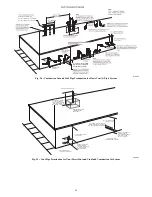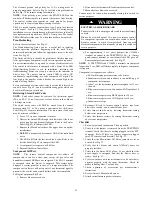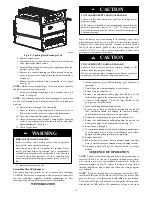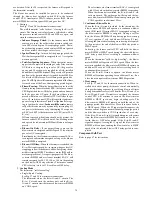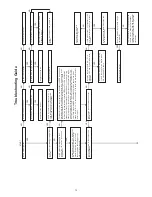
67
The electrical ground and polarity for 115--v wiring must be
properly maintained. Refer to Fig. 36 for field wiring information
and to Fig. 70 for furnace wiring information.
NOTE
: If the polarity is not correct, the STATUS LED on the
control will flashes rapidly and prevent the furnace from heating.
The control system also requires an earth ground for proper
operation of the control and flame--sensing electrode.
The 24--v circuit contains an automotive--type, 3--amp. fuse located
on the control. See Fig. 37. Any shorts of the 24--v wiring during
installation, service, or maintenance will cause this fuse to blow. If
fuse replacement is required, use ONLY a 3--amp. fuse. The control
LED will display status code 24 when fuse needs to be replaced.
Troubleshooting
Refer to the service label. See Fig. 63.
The Troubleshooting Guide can be a useful tool in isolating
furnace operation problems. Beginning with the word “Start,”
answer each question and follow the appropriate arrow to the next
item. See Fig. 69
The Guide will help to identify the problem or failed component.
After replacing any component, verify correct operation sequence.
Proper instrumentation is required to service electrical controls.
The control in this furnace is equipped with a Status Code LED
(Light--Emitting Diode) to aid in installation, servicing, and
troubleshooting. Status codes can be viewed at the indicator in
blower door. The amber furnace control LED is either ON
continuously, rapid flashing, or a code composed of 2 digits. The
first digit is the number of short flashes, the second digit is the
number of long flashes.
For an explanation of status codes, refer to service label located on
control door or Fig. 63, and the troubleshooting guide which can
be obtained from your distributor.
Retrieving Stored Fault Codes
NOTE
: Fault codes cannot be retrieved if a thermostat signal
(24-v on W, Y, G, etc.) is present, or if any delays such as blower
off-delays are active.
The stored status codes will NOT be erased from the control
memory when 115- or 24-v power is interrupted. See the Service
Label (Fig. 63) for more information. The most recent fault code
may be retrieved as follows:
1. Leave 115-v power connected to furnace.
2. Observe the status LED through the blower door (the lower
door on upflow applications) indicator. Refer to the Service
Label (Fig. 63) to interpret the LED.
3. Remove the Main/Control door (the upper door on upflow
installations).
4. BRIEFLY disconnect and reconnect ONE of the main limit
wires.
5. The LED will flash the last stored fault code. Refer to the
Service Label (Fig. 63) to interpret the LED.
6. A component test sequence will follow.
7. Reinstall the Main/Control door.
Component Self-Test
NOTE
:
The furnace control component test allows all
components to run for a short time; except the gas valve and
humidifier terminal HUM are not energized. The EAC-1 terminal
is energized when the blower is energized. This feature helps
diagnose a system problem in case of a component failure. The
component test feature will not operate if any thermostat signal is
present at the control and not until all time delays are completed.
To Begin Component Self-Test:
1. Remove blower access door.
2. Disconnect the thermostat R lead from furnace control.
3. Manually close blower door switch.
Caution must be taken when manually closing this switch for
service purposes.
ELECTRICAL SHOCK HAZARD
Failure to follow this warning could result in personal injury,
or death.
Blower door switch opens 115--v power to furnace control.
No component operation can occur unless switch is closed.
Exercise caution to avoid electrical shock from exposed
electrical components when manually closing this switch for
service purposes.
!
WARNING
4. For approximately 2 sec, short (jumper) the COM-24v
terminal on control to the TEST/TWIN 3/16—in. (5 mm)
quick-connect terminal on control until the LED goes off.
Remove jumper from terminals. See Fig. 37.
NOTE
: If TEST/TWIN and COM-24v terminals are jumpered
longer than 2 sec, LED will flashes rapidly and ignore component
test request.
Component test sequence is as follows:
a. LED will display previous status code 4 times.
b. Inducer motor starts and continues to run until Step g of
component test sequence.
c. After 7 sec the hot surface igniter is energized for 15 sec.,
then off.
d. Blower motor operates on Continuous-FAN speed for 10
sec.
e. Blower motor operates on HEAT speed for 10 sec.
f. Blower motor operates on COOL speed for 10 sec.
g. Inducer motor stops.
5. Reconnect R lead to furnace control, remove tape from
blower door switch, and re-install blower door.
6. Verify furnace shut down by lowering thermostat setting
below room temperature.
7. Verify that furnace restarts by raising thermostat setting
above room temperature.
Checklist
1. Put away tools and instruments. Clean up debris.
2. Verify that the jumper is removed from the TEST/TWIN
terminal. Verify that there is nothing plugged into the PLT
connector. (Note: If there is a jumper connector plugged
into PLT, remove it and discard.) See Fig. 37.
3. Verify that the Blower/Heat Off Delay jumpers are set as
desired. See Fig. 37.
4. Verify that the blower and control (“Main”) doors are
properly installed.
5. Verify that the Status LED glows.. If not, check that the
power supply is energized and that the blower door is
secure. See Fig. 63.
6. Cycle test furnace with room thermostat to be sure that it
operates properly with the room thermostat. Check all
modes including Heat, Cool and Fan.
7. Check operation of accessories per manufacturer’s
instructions.
8. Review Owner’s Manual with owner.
9. Attach entire literature packet to furnace.


